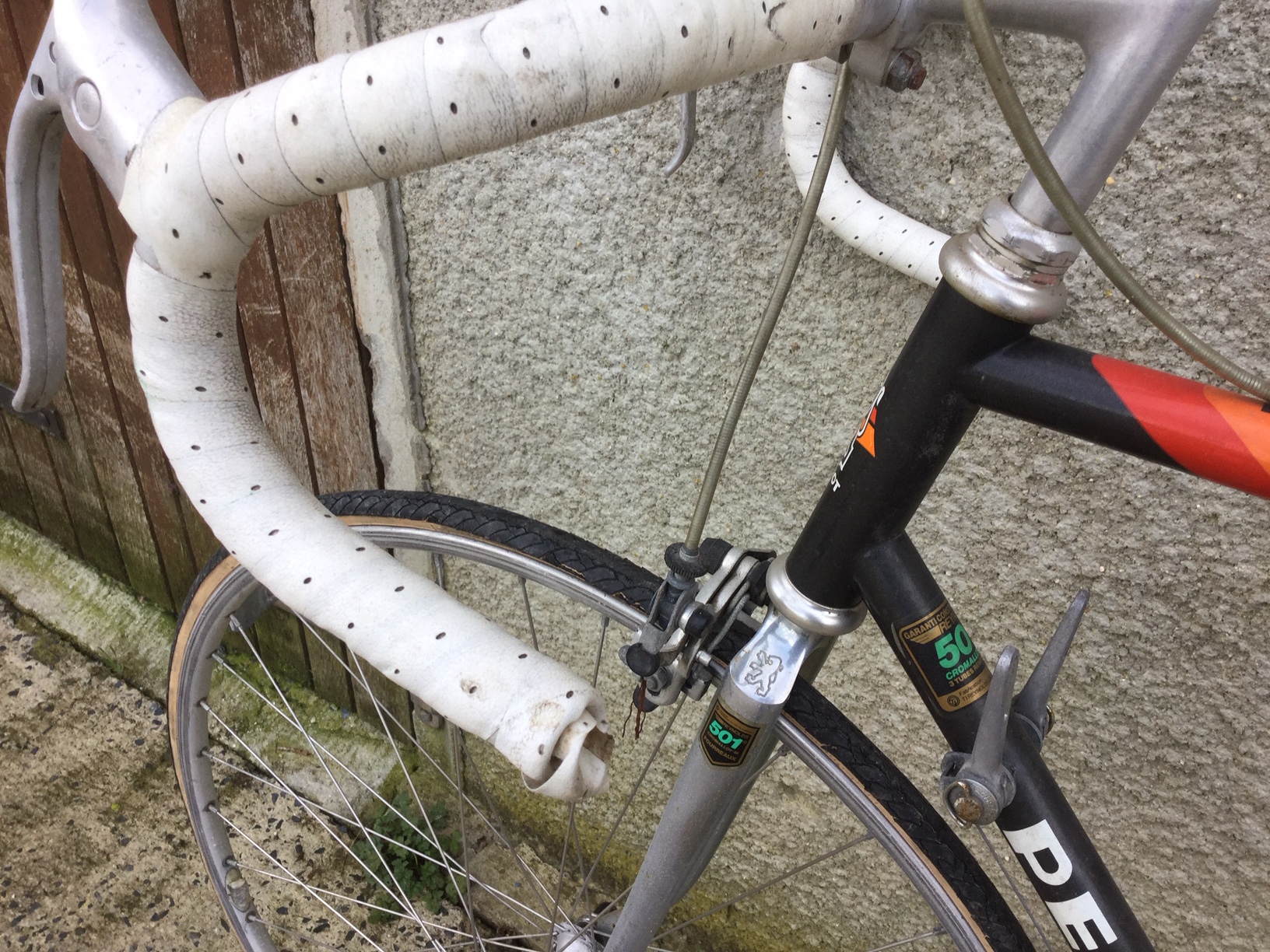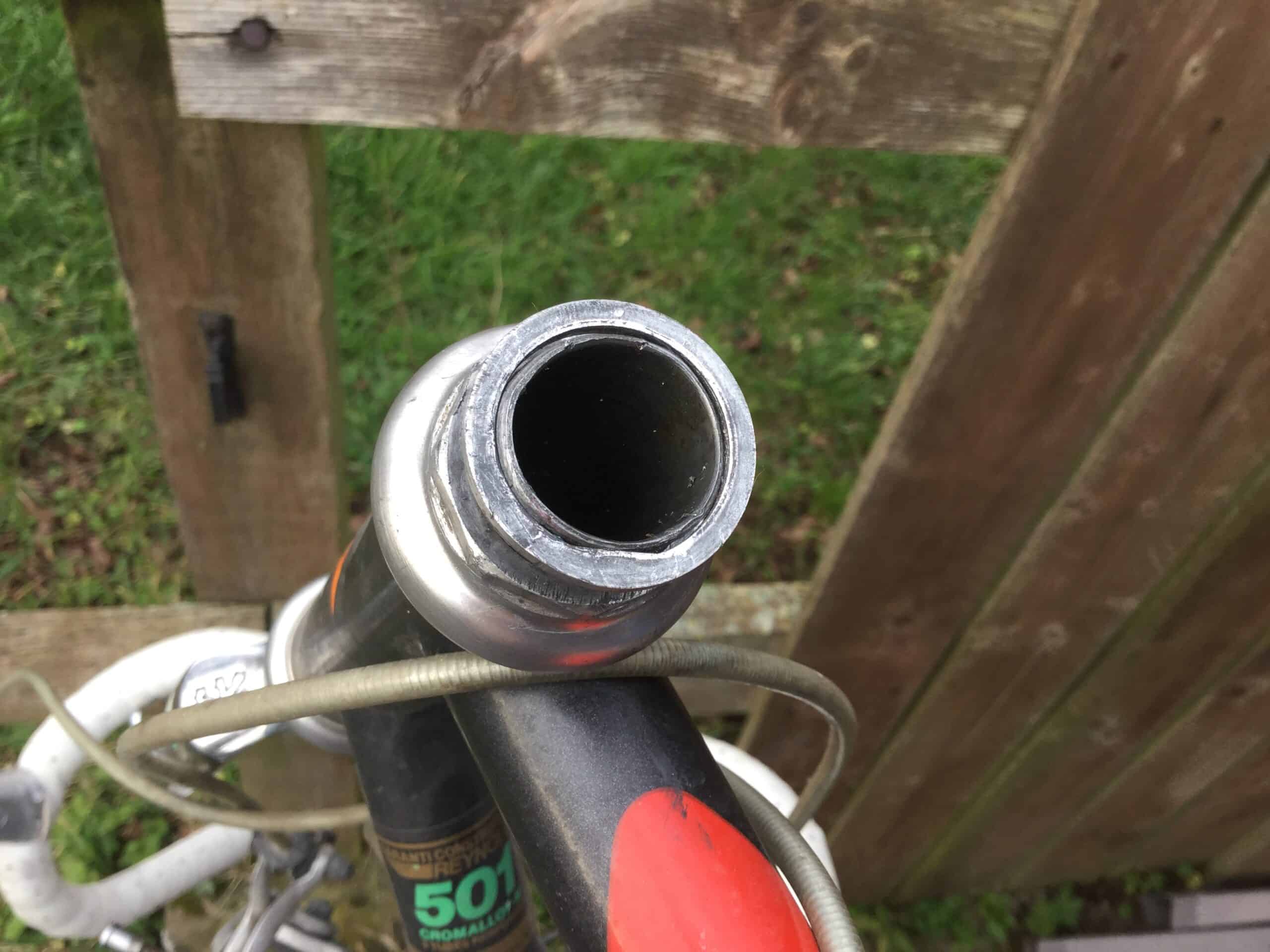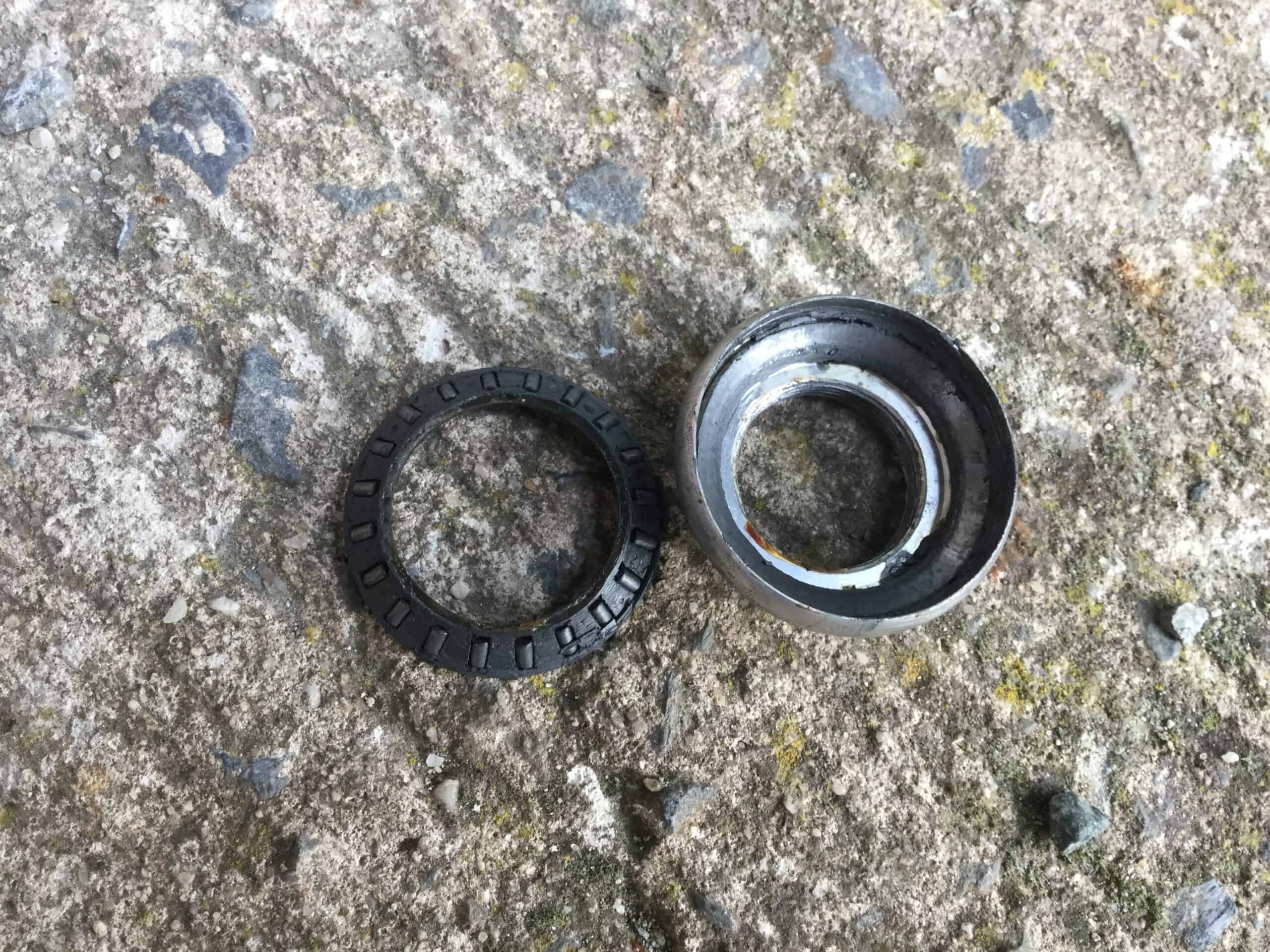Peugeot PH 501 from the 1980’s
I like this era of Peugeot bikes, a time when technology was changing and the brand’s grip on the market was slowly but surely slipping away. Peugeot were still making cool bikes at this time, I’m in doubt about it. In fact, some of my favourite bikes over the years have been Peugeot bikes made between 1984 – 1990. This particular model, the Peugeot PH 501, might not have the bragging rights of a Triathlon or PY10 LS with its inferior 501 frameset, but it was good quality bike, built with French components.

First Impressions
I can date this bike to 1985, because the Maillard Helicomatic hubs are stamped with the year they were made. I’ve just made a video about overhauling a rear Helicomatic hub in a video on Youtube. The Peugeot PH 501 is a 12 speed, 57cm with Huret derailleurs which may be on the bland side but are efficient components. In fact, nearly ever part on this bike was French made. Shimano had yet to dominate French brands at this stage of the 1980’s. But there was something not quite right with this bike. If you look at the bike straight on, there is something slightly amiss. I began to see it while I was making the video above, and the more I looked at it, the more I realised there was a problem here.

Before
The Fork
The chrome on the fork had been attacked by rust and were at the stage where they were soon to be covered in the stuff. Most of the rust, the lighter brown and orange shades of it, came off quite well with very fine steel wool and WD40. Is there a better way? Not that I have found over the years. As you can see from the photo, the drive side fork looks a lot better after the cleaning and then a turn with metal polish. But the aesthetic look of the fork turned out to be much less of a problem than a much more serious issue I found; the forks are slightly bent from a front end collision..

After
The Drama Begins
Let’s just say I was more annoyed at myself than anything when I discovered the problem. How did I miss it? Well, in my defence, I bought the bike after dark and it was a rushed event. During the 2 minute purchase, I didn’t feel any play in the headset or bottom bracket and the wheels looked fine. Further, the frame seemed free from abuse with no holes, dings anything of that nature, so I bought it. It was only when I was making the video of the bike the next day that I noticed the angle of the forks coming out of the head tube, something that your instinct tells you just doesn’t look right. What confirmed it was the friction I felt when turning the handlebars fully right or left; a sure sign ( when the headset is correctly fitted ) that the steerer is slightly bent and not correctly aligned within the head tube.

The Trinity of Bad Signs
So here are the three tell tale signs that the forks are bent:
- There is friction when the handlebars are turned fully in one direction.
- There is a slight gap between the cups at the bottom of the head tube
- The fork is not easily installed onto the hub of the front wheel.
It’s not rocket science but sometimes I’m amazed how many bikes are listed for sale with bent forks. With this bike, all three problems written above were evident, so the next question I asked myself was what to do about it. I set about taking the forks out and having a closer look at them, though I had a very good idea what I’d find. Once they were removed and I could see the steerer was slightly bent, I was determined to correct it.

Damaging the Steerer
Let’s be blunt; in my haste to correct the bent steerer, I ended up damaging it and deforming its shape at its threaded end. The basic idea had been brutally simple: to straighten the tube with a pipe of similar size with just enough force to bend the steerer back to its correct angle. However, with a sense of awe at my own stupidity, I soon realised after a few attempts at this that it had caused the steerer end to become now markedly deformed. I didn’t take a photo of it as I rather ashamed of this botched job, but the drawing of its shape above, now a mockery of a circle, is not an exaggeration. At this moment I thought about chucking the forks in the bin.

Somewhat fixed!
Recircling a Circle
Mistakes happen, especially when you don’t have the correct tools to hand. I didn’t have a “deformed steerer tube fixer” in my toolbox, so I tried something quite different, perhaps even slightly inventive: A Park Tool RT-1. This is a tool specifically designed to remove headset cups from the head tube by inserting it in there like a steerer. It is wider than a 22.2mm steerer tube, but the thought came to me: if lightly tapped into the deformed steerer hole, surely it will round it again as long as it is not tapped too much? After a few small hits with a mallet, the soft metal of the steerer had regained its shape, not 100%, I grant you, but pretty close. Champion!



Reinstalling the Fork
Because the steerer itself was damaged, I was worried that the threads themselves may have suffered enough to make reinstalling the headset a real problem, perhaps impossible. It turned out, however, that the threads were still in good enough condition; it was the imperfect shape of the of steerer that was going to defy the attempt to screw on the headset cup and lock nut. The fact remained that the steerer was not perfectly round. It was the first couple of threads that were the real challenge and I believe, in the end, these tolerances were at their limits: the headset just about managed to screw on, at times by just 1mm at each turn to prevent cross threading.


Did it Work?
The forks look slightly out of alignement on the photo above, but I think I have managed to improve the problem of the Peugeot PH 501. A sign of the changing technology in the 1980’s is the type of headset bearings used for this bike. Not loose steel balls or caged balls like many earlier Peugeot bikes, but rectangular shaped bearings within a plastic shell. Was this development in headset technology as effective as using traditional steel balls? I can’t say, but after fitting everything back together the overhaul had made an improvement, not a perfect correction.

The Rectangular Bearings
Huret Rival
This Huret gear system, however, just covers the basics and is both bland and forgettable. It had more Sachs than Huret in it, more inspired by a German conglomerate than a French workshop. The cosmetic finish on the derailleurs is pretty mediocre and there’s nothing really worth mentioning except that the derailleurs are perfectly adequate for a mid-range bike of this era. It’s as if Huret had lost all inspiration to make anything better than a functional, cost-effective transmission. It’s fine but all a bit meh..


About the Peugeot PH 501
There’s quite a lot of information out there on the Peugeot PH501, including catalogue scans here and here. The 501 was the model above the HLE, that was built with Peugeot’s own in-house steel tubing. The Ventoux, Galibier and Routier were also models of the mid 1980’s that had 501 tubes, as was the Gold Special which is a rarer find these days. These are all collectable bikes with their iconic Peugeot paintwork and decals, internally brazed tubing, lugless tubes and French components. I do so like the Peugeot crest stamped on the fork crowns, and the fact that there is still a Frenchness about these models, before aluminium bikes with their Shimano components took over the market.

Riding the Peugeot PH 501
I really enjoy riding this bike, it’s actually quite surprising just how well these mid ‘80’s bike were made. It may not be as light as its modern aluminuim equivalents, weighing as it does around 22lbs, but by Jove, it can really move and it feels lively and responsive. I’ve been riding it on gravel tracks along the river Vire and it’s dealt with the surface without twitching, even with its 700 x 20 tyres. The frame is the best part about the bike, I like it’s feel and it’s a good looking machine. The Huret transmission requires a certain precision and patience at first, but once you get the feel for the 12 gears you find the gear changes quite defined. I love riding it.

Room for Improvements
The forks may be slightly out of alignment but I don’t think it affects the safety of the bike at all. It’s really a case of whether you can live with this fault, because the bike will never look perfect. Other things that could be done are replacing the lost brake hoods, changing the original handlebar tape ( with end caps ) and buying new clincher tyres. Can you sell a bike with bent forks? I don’t really think it’s right to do so, unless the buyer has full knowledge of it and is happy to take on the project. It’s not because of any safety issue, but because the bike is fundamentally compromised. So in this case, I think I’ll just keep it and enjoy the ride.







Thanks for the write up and the very honest chronicling of your metal bashing – we’ve all done it but few are honest enough to say so. I have a similar Triathlon model which lead me here – great bikes, underdogs really. I replaced my sachs huret mechs and levers with (just about) period correct Shimano 1050 6sp indexed shifting – light years ahead of the OEM kit.
Thanks Dave, mistakes are just part of repair even after years of doing it. It’s rectifying them that’s the difference, I think 10 years ago I would have just thrown the forks in the bin. I agree about the quality of these bikes and upgrading to Shimano, I also like the Simplex SJ transmission as a better alternative. Thanks for the input!
You can fix the fork. It looks like the fork tongs themselves are out of alignment now too. Google cold setting bike forks, or visit Sheldon Brown’s website or look up RJ The Bike Guy on YouTube and search that term. Both will have loads of instructions on fixing the alignment and cold setting or pulling the fork back into place. Steel forks were set this way in the first place. Also, you can use a string to check for even alignment and adjust. If you’re not comfortable with going further take the fork to get set by a bike mechanic. You don’t want to cause damage to the wheel and the hub, by continually riding it with the fork out of alignment. Eventually, the hub will fail, and you don’t want a front wheel failing, because that’s a trip to the hospital or worse. Seriously don’t take that fork misalignment lightly. You can get away with a back wheel failing, a front one can be fatal.
You’ve got a beautiful bike. I’m restoring and building up a 1985 P10LS Aubisque right now.
Hi Dominic, I recently bought this bike 2nd hand. I am just starting in the bike world. My bike has a generator light attached to the back wheel/front of bike – 2.4 W made in W Germany. I was wondering if you knew about changing the bulb for this or someone who does? Thanks a lot I love your material.
Hi Kyle, thanks for your message. I have never changed a light bulb for a vintage dynamo, is it a question of trying to open it so you can get at the bulb? Does anyone know about this? Sorry I can’t help with this problem, I hope you find the solution. Dominic
Hey Dominic, nice write up. I recently fixed up an ’85 PH501 and once thing I noticed is that the ’85 brochure claims the original fork for this bike was “Peugeot tubing”. This is backed up by my bike having a Peugeot 103 fork, so it’s possible that your bent fork came off of a different bike.
I can confirm this. My ’85 PH501 has all-chrome Carbolite 103 forks. And yes, they do ride very nicely.
Very nice read! Do you have the seatpost diameter?
That’s a good question. I don’t think I checked that detail..
The chrome forks have the Reynolds 501 stickers, so it appears that the fork might be from a later model. The 1987 PH501 Ventoux model had these, at least they show up in the catalog. http://www.bikeboompeugeot.com/Brochures%20USA/Peugeot%201987%20USA%20Brochure/Peugeot%201987%20USA%20Brochure%20Page%2011.jpg
Hi I have recently acquired a Peugeot aubisque it’s the yellow frame with red striping. I’m not too worried about keeping it orginal as I bought the frame fork and bars only for £10 and have so far added campagnolo rear derailleur a decent set of 700c wheels I had with new continental ride tour 28c tyres.
I have made it more into a gravel/Xc bike. Over the years I have had a few nice bikes however after completing my first 50 miles on this bike I’m in love with it and would be tempted to say it’s possibly my favourite.
However I am after any more information anybody could give me about the year and exact model of the bike if possible. Thanks in advance and also nice post I enjoyed reading through you have inspired me to now start on my 1980 Peugeot routier that’s on need of some serious tlc
i have a red peaugot 501 12 speed ,,, serial # 801 xxxxx
any idea the value
Dominic- your write-up was wonderful for a newbie like me. I just found the same bike. (I think?) Is there a place on the web to check the make given the spot/tag you pointed out on the left side of the frame near the crank arm? Mine says PGN1 OM56- does this match our bike. Thanks again- I am excited to start riding a bike again.
Thanks for the message, you can look on the old Peugeot catalogue sites for the PGN model, if you know the exact year you can see the full specifications of your original bike. I believe the 56 on your sticker denotes the size, you can find what year it is by checking for date stamps on the components. Good luck with your new PGN!
just built one, used mostly suntour parts as they were the best in this era, bike rides well and shifts great, fiction shifting used suntour vgt luxe rear derailleur, just great stuff.
I have a maroon P-501, and it has been my best & fav bike for 20 years. Had to restore nine also. You are in for happy riding!
Sounds great, send a picture if you can! Cheers!